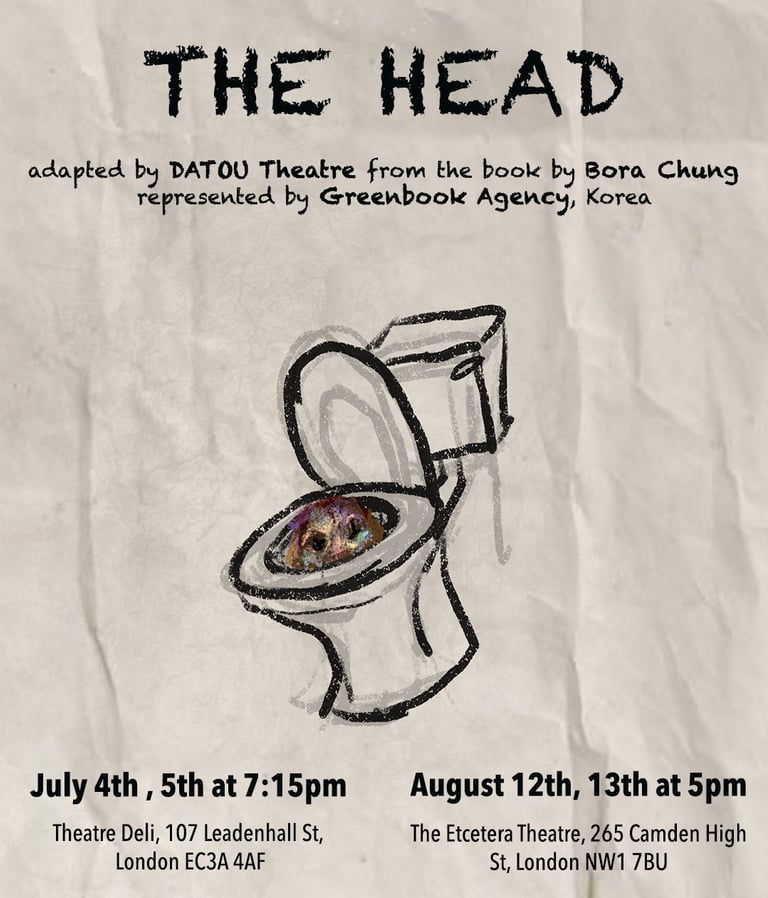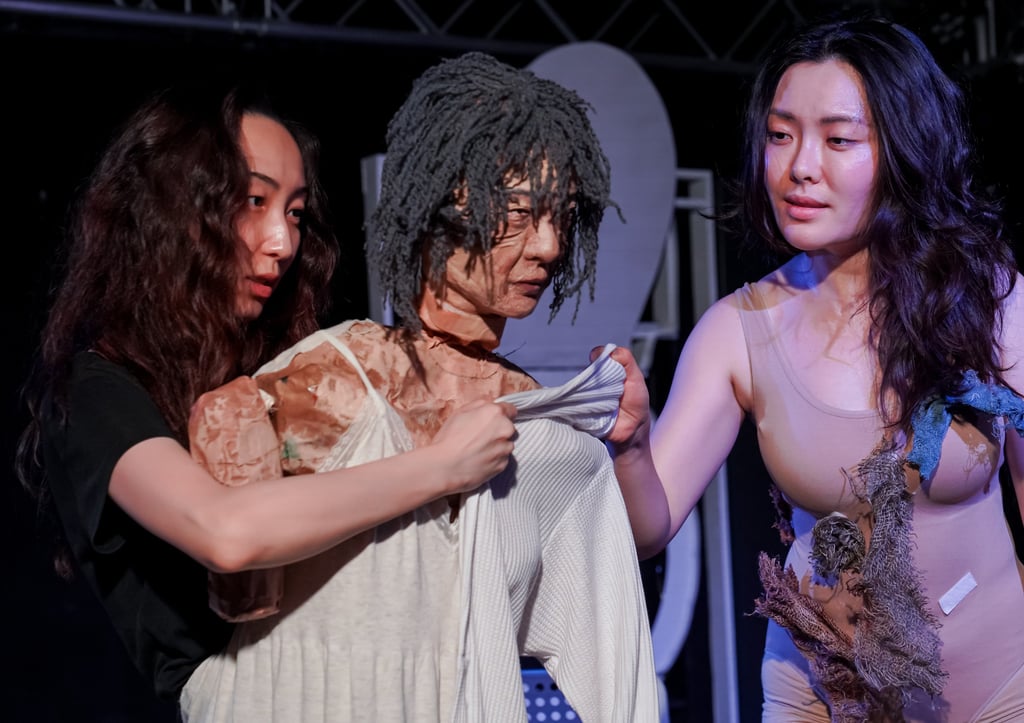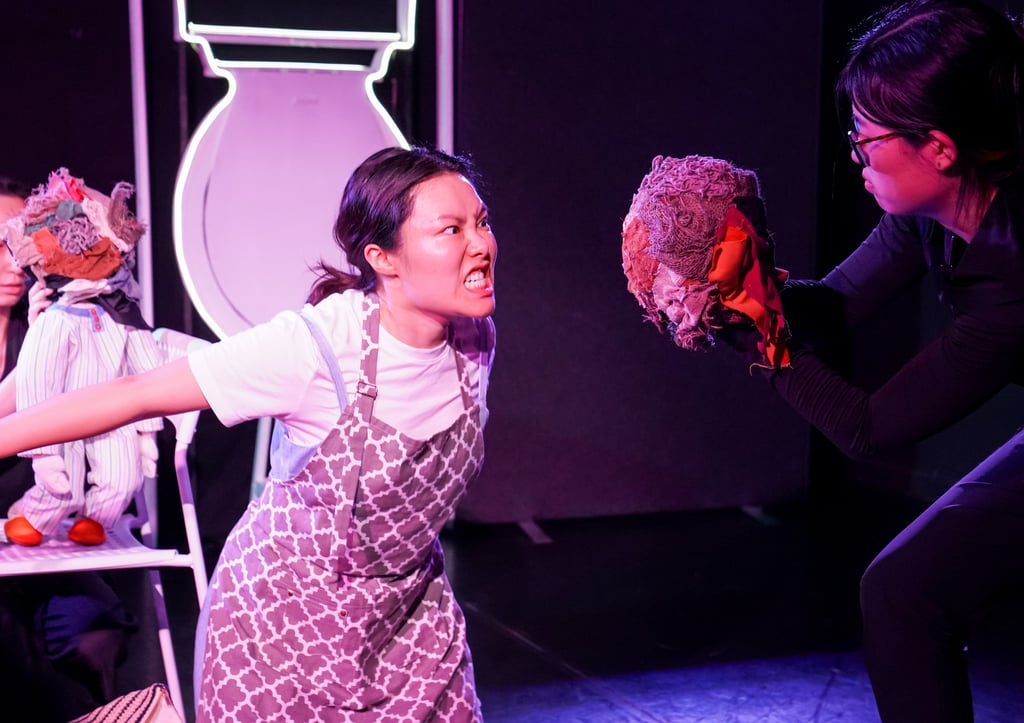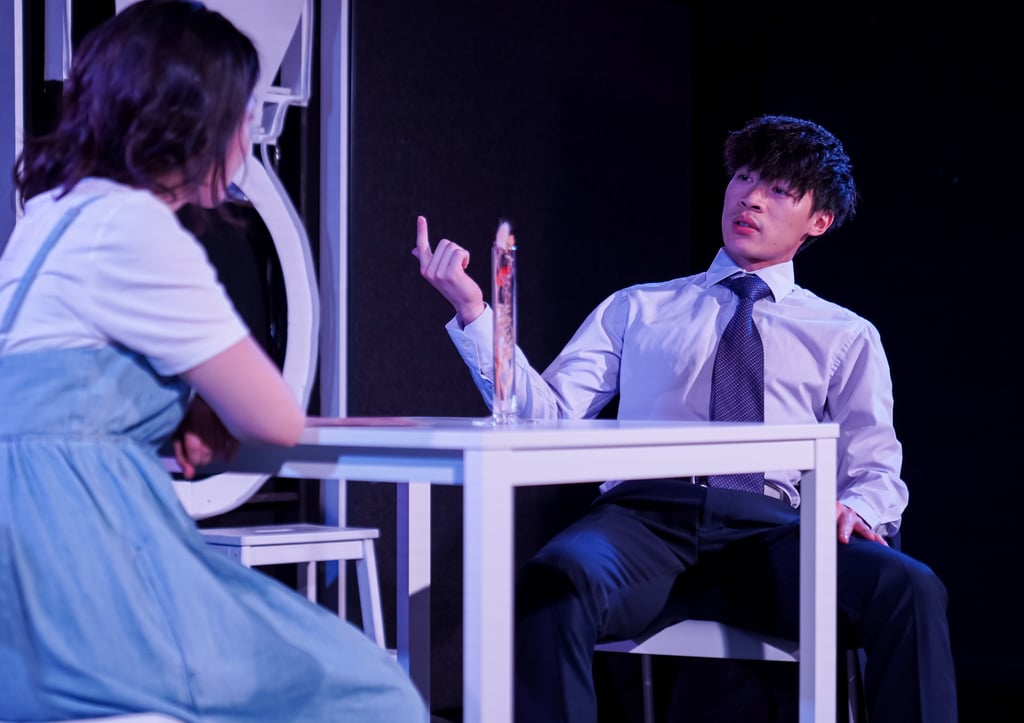REVIEW: The Head - The Unwanted Child and the Generational Chains That Bind East Asian Women
Review Date: 5th July 2025 @Theatre Deli
REVIEWS
Cassie Xue
7/6/20256 min read


Currently staged at Theatre Deli, The Head is a stage adaptation of the short story of the same name from Cursed Bunny, the internationally acclaimed collection by South Korean writer Chung Bora. Adapted by Jessica (Wenjing) Ji and Yu Song, this multimedia production transforms Chung’s piece of magical realist horror into a puppet-led theatrical work that breaks the fourth wall.
The Head is a story about generational relationships between mothers and daughters in East Asian families. The protagonist, known only as Woman (Marian Lee), encounters a grotesque “Head” emerging from her toilet. The Head claims to be her child and calls her “mother.” Made from waste, hair, and toilet paper, the Head pleads for more offerings to complete itself. To escape, Woman smears the Head’s face with a pad and flushes it, causing a clog—prompting a lecture from a plumber (Yi Hsin Wang), who warns her not to flush pads. She tells her mother (Alina Zhou), who ignores Woman’s unease and urges her to marry, yet also laments her own marital difficulties. After resigning from her job due to the Head’s haunting, Woman is set up on a blind date by her mother, who continues to neglect her emotional needs. Her husband (Yi Hsin Wang) is self-absorbed and prone to mansplaining, reinforcing Woman’s erasure in a patriarchal society. The Head’s temporary absence leads her to believe that this domestic life might be happiness.
As her daughter (Alina Zhou) enters adolescence, she too is troubled by the Head. Meanwhile, Woman becomes the kind of mother she once resisted, controlling her daughter through emotional neglect. Fear and control are passed down through generations. Eventually, the Head—now with a complete human body and the youthful appearance of Woman’s younger self (Marian Lee)—emerges from the toilet and asks for a set of clothes as a parting gift. The younger self accuses the older Woman of cruelty and abandonment, then shoves her into the toilet and flushes her away. The Head dons the Woman’s clothes and replaces her.
© DA TOU Theatre Company


One of the most distinctive and noteworthy elements of this production is its use of puppetry. Director, producer, and set designer Jessica (Wenjing) Ji and Yu Song bring the Head vividly to life with handcrafted puppets. They retain the original story’s notion of the Head as an incomplete and grotesque form, while giving it an almost Sesame Street-like charm. The daughter’s childhood self is portrayed as a puppet, which not only eliminates the need for a child actor but also establishes a symbolic link between the daughter and the Head. Later, the elderly version of Woman (Alina Zhou) is portrayed as a puppet, reinforcing that puppetry here is more than a practical device—it is a metaphor for the inescapable, cyclical generational pain within East Asian mother-daughter relationships.
In Chung Bora’s original story, the Head—a supernatural being composed of excrement, tissue, and menstrual blood—is terrifying and grotesque. It is a projection of female self-loathing: a self discarded and rejected by patriarchal society. It also represents the unwanted children—those born without expectation—and the anger that oppressed mothers can only pass down to their daughters, the only ones left to bear it. This magical realist horror is softened in the stage version through puppetry.
As the puppet Head, made from coloured fabric and papier-mâché, emerges repeatedly from the toilet centrepiece, the horror of the original is tempered by its physical presentation. Whether in Woman’s reactions or the puppet’s movements, fear is replaced by absurdity and charm. Marian Lee’s portrayal of Woman is energetic and animated; her anger at the Head is almost feline, exaggerated, making the atmosphere less suffocating. Scenes between Woman and the Head are punctuated with bouncy, rhythmic music; each time the Head appears, Woman slams the toilet lid or flushes in a panic. Their interactions become almost sitcom-like—an odd dynamic that reframes the Head not just as a monster made of waste, but, as it insists, as Woman’s child.
This sitcom-like tone continues throughout. Whether in the scene with the plumber or the arranged date with Woman’s future husband (both roles played by Yi Hsin Wang), his performances vividly portray two patronizing men who excel at mansplaining while disregarding women’s thoughts and feelings. The chemistry between Yi Hsin Wang and Marian Lee brings playful tension to the stage. Their dynamic not only highlights the arrogance of male authority figures and the systemic silencing of women in patriarchal structures but also injects levity that prevents the production from becoming overwhelmingly heavy.
Admittedly, this bold stylistic choice softens the oppressive tone that runs through Chung Bora’s original story, particularly its depiction of crushing family dynamics, women’s roles in society, intimate relationships, and the emotional gulf between mothers and daughters. The sense of inescapable despair in the short story is replaced here by a gentler, more inventive theatrical language. While this may reduce the urgency of the original, it also makes the work more accessible to younger contemporary audiences, especially through puppetry.
© LYND


This work’s use of breaking the fourth wall aligns seamlessly with its lighter tonal choices. Woman (Marian Lee) frequently delivers monologues directly to the audience. At one point, her mother (Alina Zhou) pauses while mopping the floor and asks the audience to lift their feet. Later in the play, when Woman herself becomes a mother and performs the same gesture, the inherited cycle between mother and daughter is made strikingly literal. At the same time, these moments draw the audience into the world of the play, transforming them into participants who share in the roles of both daughter and mother. This theatrical device narrows the distance between the viewer and the character, inviting emotional investment. These metatheatrical moments also serve as metaphors for the characters’ fates, which reflect reality itself. When the Woman looks out and asks the audience, “Can you feel me?” the line resonates as a pointed allusion to “all the world’s a stage,” reminding us that what we are witnessing is both performance and painful truth.
Another highlight of the production is its fluid scene transitions, achieved through thoughtful sound design (by Mingyu Ding) and lighting design (by Yuqing Wang). The coordination between these elements creates a seamless narrative flow. Whether it’s the playful, whimsical melodies during comedic skirmishes between Woman and the Head, or the heavy, melancholic music during the final confrontation between the elderly Woman and the fully formed Head, the sound design establishes a distinct emotional tone for each scene.
Lighting shifts and simple visual cues are used with great precision. For instance, merely placing straw hats on Woman and her husband, combined with changes in light, signals both the passage of time and a shift in emotional tone. These subtle gestures contribute to remarkable clarity in storytelling, executed with finesse.
© LYND


Finally, one of the most notable—and arguably problematic—elements of this adaptation lies in its heavy reliance on the original text. Jessica (Wenjing) Ji and Yu Song quote directly and extensively from Chung Bora’s prose. Since The Head is a short story rather than a dramatic text, a stage adaptation should ideally involve a more substantial transformation. Almost all of Woman’s monologues, the dialogues with the Head, and the climactic confrontation with the elderly Woman are lifted line by line from the original story.
Yet writing for theatre and writing for fiction require entirely different approaches. Adaptors and dramaturgs must be mindful of this distinction. This is not an adaptation of Shakespeare or other dramatic classics, where fidelity to the original language is part of the tradition. The same approach does not translate effectively when adapting a short story. This issue becomes particularly visible in the dialogue, where there is a noticeable disconnect between newly written lines and those taken directly from Chung Bora’s prose. Despite the clever use of puppetry and theatrical techniques that help mask this inconsistency, the emotional texture of the characters’ voices remains uneven.
Through a more visually engaging and tonally accessible form, The Head reshapes the grotesque metaphor of a toilet-born creature. By incorporating puppetry, this adaptation lends a gentler voice to a deeply bodily and psychologically haunting story. It speaks to the wounds passed down through generations of women—maternal emotional neglect, the oppression of patriarchy, and the cycles of trauma within East Asian families.
★★★★
This show will next be performed at the Etcetera Theatre, Camden, 12th & 13th August at 5 pm https://camdenfringe.com/events/the-head/. For more information, please visit: https://www.instagram.com/datou_theatre/
Credits
Cast: Marian Lee, Alina Zhou, Yi Hsin Wang
Script Adaptation: Jessica (Wenjing) Ji & Yu Song
Director: Jessica (Wenjing) Ji
Producer: Yu Song
Lighting Designer: Yuqing Wang
Head of Sound / Sound Designer: Mingyu Ding
Co-Sound Designer: Katia Qi Shi
Set & Costume Designers: Jessica (Wenjing) Ji & Yu Song
Movement Director: Ksenia Elinson
Puppetry Supervisor: Aki Nakagawa
© LYND
Sound Behind Curtain
A place for all Asian artists.
© 2025 Sound Behind Curtain - Operated by Mujian Ltd (SC840410). All rights reserved.
Your gift keeps the curtain rising for Asian creatives.
About
Contact
